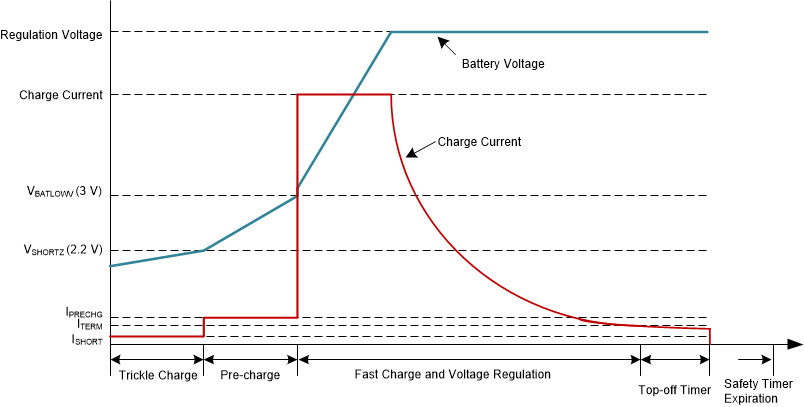ZHCSLX8B October 2020 – July 2024 BQ25618E , BQ25619E
PRODUCTION DATA
- 1
- 1 特性
- 2 应用
- 3 说明
- 4 说明(续)
- 5 器件比较表
- 6 引脚配置和功能
- 7 规格
- 8 详细说明
- 9 应用和实施
- 10电源相关建议
- 11布局
- 12器件和文档支持
- 13修订历史记录
- 14机械、封装和可订购信息
8.3.5.2 电池充电曲线
该器件分五个阶段为电池充电:电池短路、预充电、恒流充电、恒压充电和充电完成涓流充电(可选)。在充电周期开始时,器件会检查电池电压并相应地调节电流和电压。
充电器输出和电池端子(例如电路板布线、连接器、MOSFET 和检测电阻器)之间的电阻可能会迫使充电过程过早地从恒流变为恒压并增加充电时间。为了缩短充电周期,该器件提供了 BATSNS 引脚以延长恒流充电时间,从而为电池提供最大功率。BATSNS 引脚应直接连接到电池端子,以远程检测电池电压。当电池电压高于 VBAT_DPLZ 时,充电器将检测 BATSNS 引脚是否连接到 BAT。
- 如果 BATSNS 引脚未连接到 BAT,则 BATSNS_DIS = 1,并且充电器通过 BAT 引脚调节电池电压
- 如果 BATSNS 引脚连接到 BAT,则 BATFET_DIS = 0,并且充电器通过 BATSNS 引脚调节电池电压
当电池电压低于 VBAT_DPLZ 时,充电器将通过 BAT 引脚自动调节充电电压,而无需 BATSNS 检测。
- 当电池电压上升至高于 VBAT_DPLZ 时,主机可将 BATSNS_DIS 设置为 0 以启动 BATSNS 检测
表 8-3 充电电流设置
| VBAT | 充电电流 | 默认设置 | CHRG_STAT |
|---|---|---|---|
| < 2.2V | IBAT_SHORT | 25mA | 01 |
| 2.2V 至 3V | IPRECHG | 40mA | 01 |
| > 3V | ICHG | 340mA | 10 |
 图 8-2 电池充电曲线
图 8-2 电池充电曲线